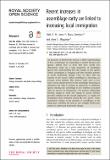Files in this item
Recent increases in assemblage rarity are linked to increasing local immigration
Item metadata
| dc.contributor.author | Jones, Faith A M | |
| dc.contributor.author | Dornelas, Maria | |
| dc.contributor.author | Magurran, Anne | |
| dc.date.accessioned | 2020-08-03T14:30:18Z | |
| dc.date.available | 2020-08-03T14:30:18Z | |
| dc.date.issued | 2020-07-29 | |
| dc.identifier | 269050458 | |
| dc.identifier | 7f8d6aab-55c7-43f7-a268-d88575af6bb5 | |
| dc.identifier | 000556830500001 | |
| dc.identifier | 85090162774 | |
| dc.identifier.citation | Jones , F A M , Dornelas , M & Magurran , A 2020 , ' Recent increases in assemblage rarity are linked to increasing local immigration ' , Royal Society Open Science , vol. 7 , no. 7 , 192045 . https://doi.org/10.1098/rsos.192045 | en |
| dc.identifier.issn | 2054-5703 | |
| dc.identifier.other | ORCID: /0000-0002-0036-2795/work/78527922 | |
| dc.identifier.other | ORCID: /0000-0001-6571-714X/work/78528180 | |
| dc.identifier.uri | https://hdl.handle.net/10023/20399 | |
| dc.description | F.A.M.J.'s PhD was financed by the School of Biology, University of St Andrews. M.D. and A.E.M. acknowledge funding by the Leverhulme Trust. A.E.M. acknowledges funding from the European Research Council (ERC AdG BioTIME 250189 and ERC PoC BioCHANGE 727440). | en |
| dc.description.abstract | As pressures on biodiversity increase, a better understanding of how assemblages are responding is needed. Because rare species, defined here as those that have locally low abundances, make up a high proportion of assemblage species lists, understanding how the number of rare species within assemblages is changing will help elucidate patterns of recent biodiversity change. Here, we show that the number of rare species within assemblages is increasing, on average, across systems. This increase could arise in two ways: species already present in the assemblage decreasing in abundance but with no increase in extinctions, or additional species entering the assemblage in low numbers associated with an increase in immigration. The positive relationship between change in rarity and change in species richness provides evidence for the second explanation, i.e. higher net immigration than extinction among the rare species. These measurable changes in the structure of assemblages in the recent past underline the need to use multiple biodiversity metrics to understand biodiversity change. | |
| dc.format.extent | 9 | |
| dc.format.extent | 605626 | |
| dc.language.iso | eng | |
| dc.relation.ispartof | Royal Society Open Science | en |
| dc.subject | Rarity | en |
| dc.subject | Biodiversity change | en |
| dc.subject | Immigration | en |
| dc.subject | Invasive species | en |
| dc.subject | QH301 Biology | en |
| dc.subject | DAS | en |
| dc.subject | SDG 10 - Reduced Inequalities | en |
| dc.subject.lcc | QH301 | en |
| dc.title | Recent increases in assemblage rarity are linked to increasing local immigration | en |
| dc.type | Journal article | en |
| dc.contributor.sponsor | European Research Council | en |
| dc.contributor.sponsor | European Research Council | en |
| dc.contributor.institution | University of St Andrews. Centre for Biological Diversity | en |
| dc.contributor.institution | University of St Andrews. Marine Alliance for Science & Technology Scotland | en |
| dc.contributor.institution | University of St Andrews. Scottish Oceans Institute | en |
| dc.contributor.institution | University of St Andrews. Institute of Behavioural and Neural Sciences | en |
| dc.contributor.institution | University of St Andrews. St Andrews Sustainability Institute | en |
| dc.contributor.institution | University of St Andrews. Fish Behaviour and Biodiversity Research Group | en |
| dc.contributor.institution | University of St Andrews. Centre for Research into Ecological & Environmental Modelling | en |
| dc.contributor.institution | University of St Andrews. School of Biology | en |
| dc.identifier.doi | https://doi.org/10.1098/rsos.192045 | |
| dc.description.status | Peer reviewed | en |
| dc.identifier.grantnumber | 250189 | en |
| dc.identifier.grantnumber | 727440 | en |
This item appears in the following Collection(s)
Items in the St Andrews Research Repository are protected by copyright, with all rights reserved, unless otherwise indicated.

